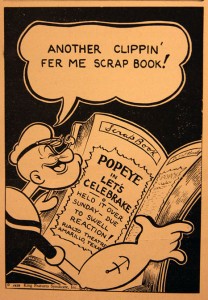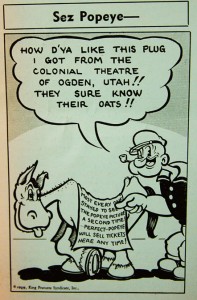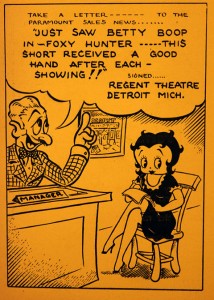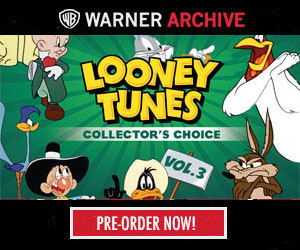
Bit of a downer after last week’s variety… Back to Popeye and Betty only. But we’ll be seeing more Fleischer faces in weeks to come.
The May 4, 1938 installment is the most foreboding gag we’ll ever see in this series. It works on the “cute” level that Betty is concerned she won’t get her fair share of her cartoons’ profits from Uncle Max. But really, it had to be known at this point within the studio that Betty was getting to be something of a chestnut and she wouldn’t be Boop-Oop-a-Dooping much longer. Pension, anyone?
At the time though, Paramount Sales News had to sell these things, so that reading of the panel may be way off. The Betty series probably needed all the hawking it could get, whereas Popeye’s greatness seemed unstoppable.
May-June 1938 (click image to enlarge)
ABOVE: The short that received a “good hand after each showing” at the Regent Theatre in Detroit Michigan – The Foxy Hunter (released November 26th 1937). Betty Boop is only in about 60 seconds of the seven and a half minute film – typical of her true status at this point.
BELOW: Two shorts released by Paramount during the period the cartoons above appeared in print. First up, Popeye in Plumbing Is A “Pipe” (released June 17th 1938)
BELOW: By popular demand, Fleischer’s Academy Award nominee for 1938, the Color Classic, Hunky and Spunky (released June 24th, 1938). Enjoy!











 THAD KOMOROWSKI is a writer, journalist, film restorationist and author of the acclaimed (and recently revised) Sick Little Monkeys: The Unauthorized Ren & Stimpy Story. He blogs at
THAD KOMOROWSKI is a writer, journalist, film restorationist and author of the acclaimed (and recently revised) Sick Little Monkeys: The Unauthorized Ren & Stimpy Story. He blogs at 

























































Hey, it was nominated for an Academy Award, so it has to be good, right?
On a more serious note, while I may lose any street cred I have on this board by saying anything positive about this series, I’ve always liked the song in this short, “Keep A-Goin'”. More shockingly, I actually like three of the shorts in this series: “The Barnyard Brat”, “Snubbed by a Snob”, and “Vitamin Hay”. They pale in comparison to the Popeyes and the better Looney Tunes being produced during the same period, but on their own terms I find them amusing enough.
“Snubbed by a Snob” at least has the merit of being a not-very-subtle jab at the racism of the 1940 South where the Fleischer Studios had relocated to (though for kids, Pinto Colvig’s singing bull was the highlight of the reel). Vitamin Hay, being made well after the other Hunky & Spunky shorts (and after the studio had worked through both of its features), visually feels more like the first Noveltoon than the last Color Classic, in terms of design and character movement, especially in the second half of the cartoon.
The first Betty panel above, with ‘Max’ does almost reads as if Ms. Boop is chastising him (or the theater owners) for taking her for granted after all that she had done for their box office in the past. But to the theater owners of 1938, you’re only as good as your latest Pudgy cartoon.
Sorry! I’m with Jody M., think the H&S theme song is pretty good, and the three tiles she mentioned, particularly BARNYARD BRAT, more than okay. Only thing weirder than the trick voices is Spunky’s top heavy character design.
Oh, and I’m diggin’ these Fleischer ads that call out specific cartoons!
Well, it does seem to confirm that Pudgy was indeed a crowd pleaser…at least for a time. At any rate, it’s very interesting to read reaction to specific cartoons. Sure, they’re puff pieces but still interesting nonetheless.
btw, who was Sam Palmer?
Sam Palmer was editor of Paramount Sales News.
Great post today and thank you so much for signing my copy of Sick Little Monkeys at Comic-Con. How many of these ads are left?
PLENTY. We’re just about half-way through at this point. And you’re welcome!
It’s interesting that the Betty Boop ad from 5-18-38, refers to “The Impractical Joker” (1937) as “The PRACTICAL Joker”! Is this a mis-print from the Studio Intermountain Theater report, or a mistake by the Paramount Sales News? Or could it be the working title? Thanks Thad, for all these impressive clippings!
I kind or stopped following the story of “Hunky and Spunky” (sounds like a gay magazine) and just marveled at the backgrounds – those dramatic clouds, and purple mountains, like an Old West painting by Frederic Remington.
The 5/11/38 one is ironic, since Bluto was absent from the Popeye series for most of 1938.